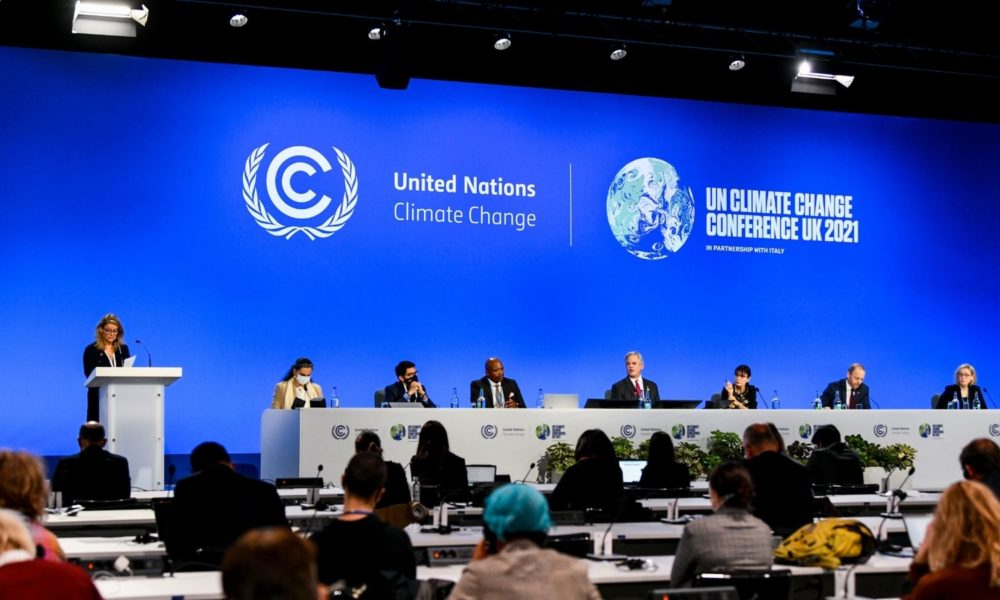Nation-states have been trying for nearly 30 years to address climate change through global diplomacy. Creating mechanisms and processes for making global commitments to address climate change is no easy task and, while a future in which global warming is limited to 1.5 degrees Celsius (1.5° C) above pre-industrial levels is still scientifically possible, the commitments that governments have made so far will not get us there– and not nearly enough is being done to help communities that are suffering from the impacts of climate change today.
I left COP26 more convinced than ever that climate litigation has an important role to play to help ensure the changes we vitally need to prevent worse impacts from climate change.
Pushing back on fossil fuel industry power
While at COP26, I was told over and over again that the process is incremental and that we are moving in the right direction. To some extent, this is certainly true.
Before the Paris Agreement was signed in December 2015, the world was on track for 4° C of warming; after the meetings in Scotland and assuming the commitments nations made there are realized, we are on track for a reality closer to 2.4° C of warming.
Unfortunately, 2.4 degrees would be devastating—and it is not aligned with the Paris Agreement, a legally binding international treaty with a stated goal to limit global warming to well below 2, and as close to 1.5 degrees Celsius as possible, compared to pre-industrial levels. So, change is happening and it is incremental, as the process promised.
During the meetings, speakers repeated that the science is clear. It’s clear that we need to limit emissions. It’s clear where the emissions are coming from. Yet, there’s no question something huge is standing in the way of real change. Standing in those meeting rooms, the sheer influence of the fossil fuel industry at the negotiations was also on clear display.
While most of the oil and gas CEOs were not in Scotland, their representatives were there in full force. According to a data analysis of the participant list by Corporate Accountability, Corporate Europe Observatory, Glasgow Calls Out Polluters, and Global Witness, there were more than 500 delegates at these meetings associated with the fossil fuel industry, including the World Petroleum Council and the World Coal Council.
Walking away from COP26, it sure felt like we need other tools to help ensure that we can address the root cause of climate change and overcome fossil fuel industry disinformation and obstruction.
The role of litigation
During the meetings I helped organize an official side event on “Litigation, fair share, and the climate responsibilities of governments and fossil fuel companies.” I was joined by Lucy Maxwell at the Urgenda Foundation, Annalisa Savaresi at University of Eastern Finland, Florencia Ortuzar at AIDA, Danilo Farias from ALANA, and Lavanya Rajamani at the University of Oxford.
Here are five key takeaways from the event:
1. Courts have an important role to play
Over the last five years, the courts have made it clear that they have the power to rule on cases related to climate change and that governments and companies have a legal duty to address climate change, which includes reducing emissions and helping communities prepare and adapt to any unavailable impacts. These decisions are being made based on science, and international and human rights law. The impacts of judicial decisions will continue to grow with new cases and new venues, including increased use of international legal bodies such as the international court of justice.
2. Legal human rights standards can be effective
Increasingly, global climate litigation is relying on legal standards of human rights. Human rights laws provide avenues for individuals and communities impacted by climate change to address their grievances in the courts. Human rights law was not designed to address the impacts and realities of climate change, but it has proven to be a powerful tool.
3. It is important to track climate litigation around the globe
Climate litigation is a global tool. Colleagues from AIDA in Latin America are launching a new online platform to help identify and update the region on climate litigation. This platform will serve to build out a community of practice for communities, litigators, and scientists working on climate litigation. The growth of climate litigation is undeniable and new platforms can help to ensure that we are tracking important cases and learning from each other.
4. We need science-based emissions reductions standards
The COP negotiations are largely focused on mitigation, or future emissions reductions by governments. This is the heart of the Paris Agreement. However, there are still important questions that need to be answered about how emissions reduction levels are determined. It doesn’t make sense to demand that every nation-state reduce emissions at the same rate – the United States and other countries whose cumulative historical emissions are highest bear the greatest responsibility to slash emissions swiftly. Litigation and science can play key roles in addressing national and corporate obligations in an equitable way. Scientific analysis can produce increasingly accurate emissions reduction standards for individual countries based on equitable ranges.
5. Scientific advancements can help the courts better address climate change
Climate change is a collective problem, which courts are equipped to tackle. The scientific community has embraced research that helps to inform public policy, and increasingly we need to think about research that will inform climate litigation. Work by one of my fellow event panelists, Dr. Rajamani, models this perfectly. Dr. Rajamani and her colleagues understood what climate decisions were being made in the courts and used that lens to frame their collaboration and research. Ultimately, her team helped provide methods for generating heat-trapping emission benchmarks, which are being assessed in the courts. are current undeniable gaps in our global law and policy to address climate change. As a result, litigation is crucial. Today we are seeing critical wins in climate litigation, such as those in Germany and the Netherlands. With a growing number of cases, there is hope for further and faster advancement of climate action and increased accountability for the governments and corporate actors that are driving climate change.
A powerful and growing tool
It has been one month since the final agreement was signed at COP26. The Union of Concerned Scientists covered the negotiations during the talks and provided some reflections afterwards—and I shared my own thoughts on an episode of the UCS Got Science? podcast. My experiences at these international climate negotiations have helped shape my thinking about the work we do at the UCS Science Hub for Climate Litigation. Experiencing the tedious process of global consensus making influenced by power, money, and corporate greed has given me a new perspective on the role that litigation can play in creating a safer climate future for the world.
While the COP experience was pretty shocking for a novice in the international policy space, connections I made during the meeting solidified for me that climate litigation is a growing and powerful tool we can use to limit the worst effects of climate change across the globe.
We are at the very beginning of a new movement of climate litigation. As we continue this work we can’t ignore the ongoing cost and impacts of climate change and the deadly consequences that environmental defenders face across the globe. As the global negotiations move forward, I am working hard toward increased acknowledgment of the role of fossil fuels in the climate crisis and meaningful commitments by wealthy nations and corporations to address loss and damage from the horrific impacts of climate change that we face today.

